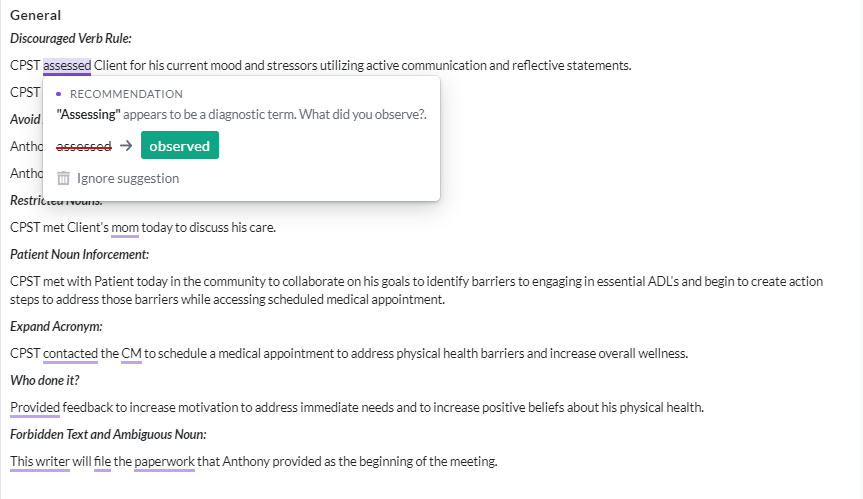Spelling and Grammar
Bells will help you with your spelling and grammar by underlining the mistakes you make.
When you see text with a red underline, simply hover your mouse over the word or words and Bells suggestions on how to improve it will appear. If you wish to apply the correction, click it and the incorrect text will be replaced.
Example spelling error:

Example grammar error

Documentation Recommendations

Examples of Documentation Recommendations:
- Discouraged Verbs - Discourages staff from using particular verbs that might not meet their credentials.
- Avoid Assessing - Ensures only properly credentialed staff can make assessments in their notes.
- Forbidden Text - These should simply never be written in notes. Can be anything!
- Patient Labels - Enforce your agency's preferred label for the people they serve.
- Expand Acronyms - Helps to encourage your staff to write out the full form of an acronym.
You can watch a webinar on Documentation Recommendations here: Making the Most of Documentation Recommendations Webinar
Viewing the Documentation Recommendations
- Click the Settings Gear in the bottom left Navbar
- Under Organization Settings select Documentation Recommendations
- You now see all of the categories for the Documentation Recommendations
- Looking at each section you can see all of the recommendations you have configured
Configuring Documentation Recommendations
From the Documentation Recommendations display, find the category you would like to set up for documentation recommendations.
Each category includes a button that allows you to further set up the recommendation:
 Clicking the Add New button will allow you to set up new recommendations based on the category.
Clicking the Add New button will allow you to set up new recommendations based on the category.
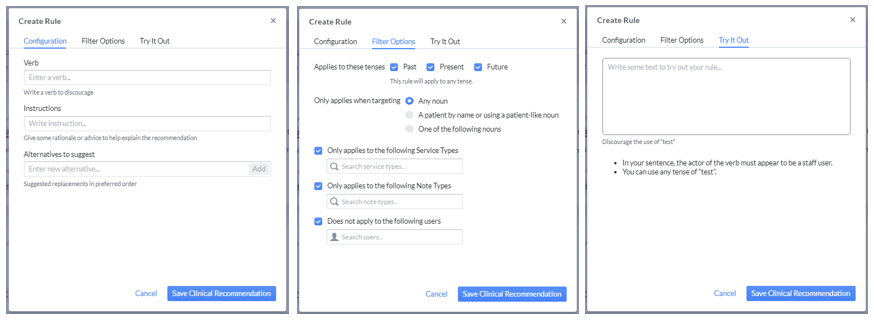
The create rule window is broken up into three tabs.
The Configuration tab is for the main setup of the recommendation.
The Filter Options tab is for the services, notes, nouns, tenses, etc where the recommendation will be enabled.
 myAvatar users: Service Types are called Service Codes. myEvolv users: Service Types are called Services.
myAvatar users: Service Types are called Service Codes. myEvolv users: Service Types are called Services.
The Try It Out tab is where you can see the setup recommendation in action and be able to see it working before utilizing it in the progress note.
The display will look the same when editing the recommendation, the window will be titled Edit Rule.

Clicking the Configure button will allow you to configure the recommendations based on the category.
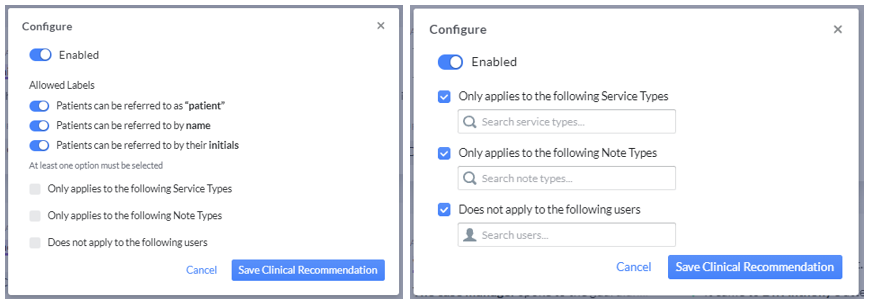
The configure window is only one tab and allows you to enable the configuration and allow the setup for specific service or note types.
Note: Each category of the Documentation Recommendations add/configure displays will be different to allow for the specified setup or configuration.
 Once a configure type rule is configured, the button text will change to Modify Configuration. This will allow users to know the rule is configured, without having to click into the rule to review.
Once a configure type rule is configured, the button text will change to Modify Configuration. This will allow users to know the rule is configured, without having to click into the rule to review.
The documentation recommendations will be used as part of the progress note writing experience.
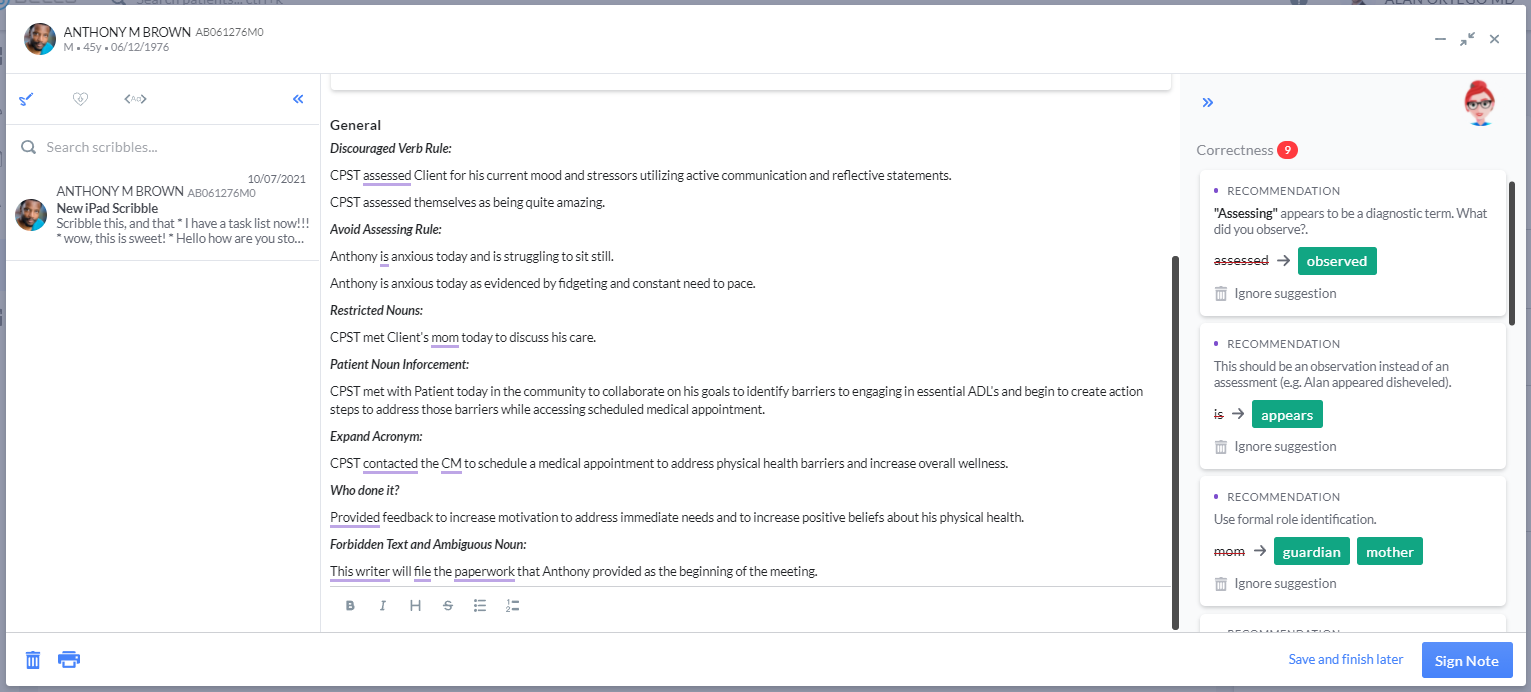
Once a Documentation Recommendation rule is configured and saved, that rule can then be copied or deleted. The Copy and Delete buttons show in the bottom left corner of the Edit Rule display.
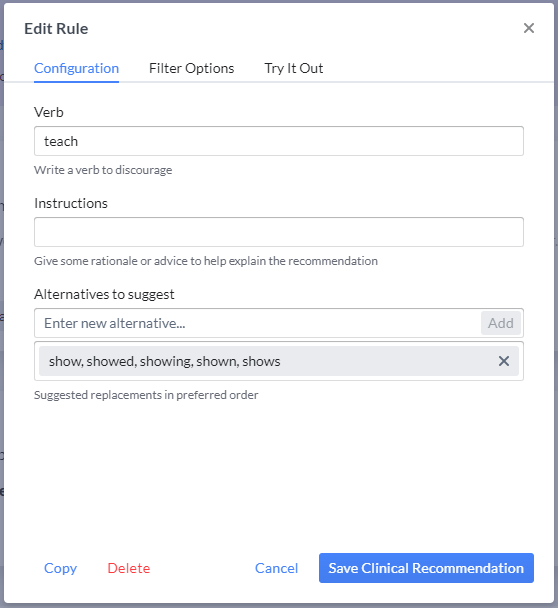
When Copy is clicked, a new rule window will open. The new rule window is an exact replica of the rule selected for copy. This will make configuring and setting up new rules faster and easier.
When Delete is clicked, a prompt will ask if you're sure, clicking "Yes, delete" will delete the rule. Clicking No will return you to the rule to continue to edit or cancel.
Documentation Recommendation Import Library

Clicking the " + Import from Library" button will open a new display to choose rules to import to your Documentation Recommendations to set-up.
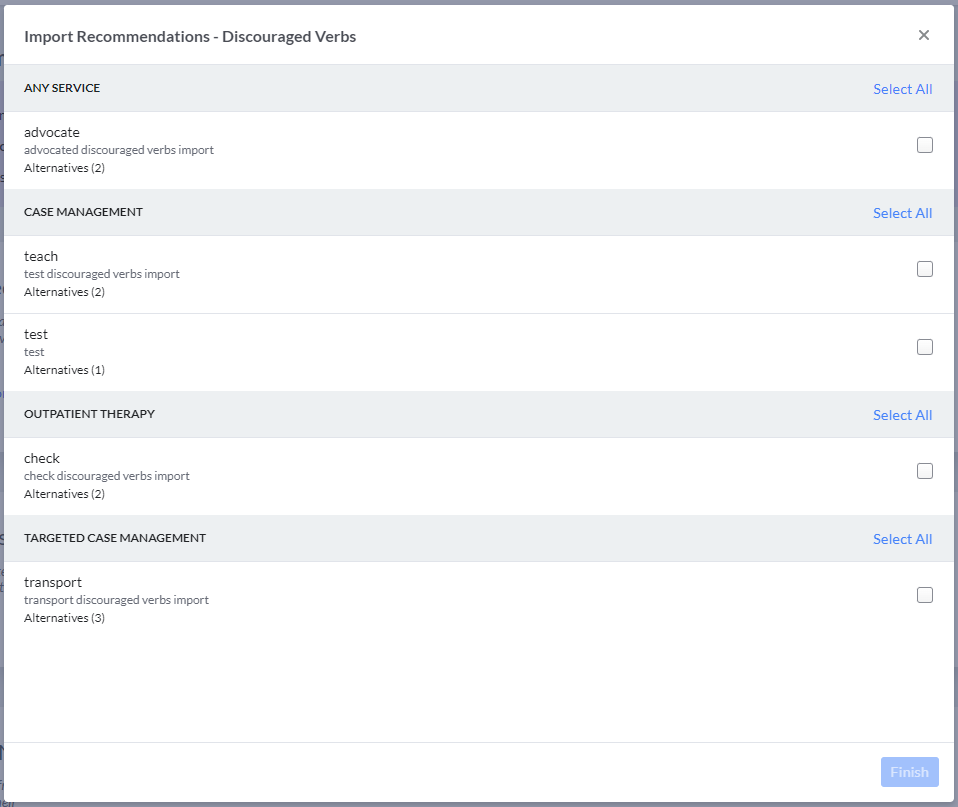
In the new display - Import Recommendations you will see available rules grouped by categories (headers in gray) followed by the rules for each of those categories. You can select all the rules in the category or select one or many rules to import across multiple categories. The categories are examples of types of services the rules might be associated with and the "Any Service" category can be associated across all the services.
Once a rule is imported, the rule will show amongst the other configured rules for your organization and can be further set-up for use in progress notes just like any other documentation recommendation.
Documentation Recommendations Capabilities

Recommendation Categories
Discouraged Verbs
Discourages staff from using particular verbs that might not meet their credentials.

Discouraged Verb example:
Entered: CPST assessed the Patient for his current mood and stressors utilizing active communication and reflective statements.
Recommended: CPST noted the Patient for his current mood and stressors utilizing active communication and reflective statements.
Avoid Assessing
Ensures only properly credentialed staff can make assessments in their notes.

Avoid Assessing example:
Entered: "Anthony was anxious today and was constantly fidgeting and needing to pace."
Recommended: "Anthony appeared anxious today and was constantly fidgeting and needing to pace."
Restricted Nouns
Prevents staff from using specific nouns as part of the progress note.

Restricted Nouns example:
Entered: CPST met the Patient's mom today to discuss his care.
Recommended: CPST met the Patient's mother today to discuss his care.
Ambiguous Nouns
Reduces the ambiguity of nouns by requiring adjectival or adverbial modifiers.

Ambiguous Nouns example:
Entered: This writer will file the paperwork that Anthony provided at the beginning of the meeting.
Recommended: This writer will file the intake paperwork that Anthony provided at the beginning of the meeting.
Forbidden Text
Restricts words or phrases from being used in progress notes. These should simply never be written in notes.

Forbidden Text example:
Entered: This writer will file the paperwork that Anthony provided at the beginning of the meeting.
Recommended: I will file the paperwork that Anthony provided at the beginning of the meeting.
Patient Labels
Enforces your organization's preferred label for the people they serve.

Patient Noun enforcement example:
Agency is configured to use "Client"
Entered: CPST met with the Patient today in the community to collaborate on his goals to identify barriers to engaging in essential ADL's and begin to create action steps to address those barriers while accessing scheduled medical appointments.
Recommended: CPST met with the Client today in the community to collaborate on his goals to identify barriers to engaging in essential ADL's and begin to create action steps to address those barriers while accessing scheduled medical appointments.
Expand Acronyms
Encourages staff to write out the full form of an acronym. This is similar to the Expansions feature but is at the organization level instead of the individual user level. Like expansions, the acronyms can be configured to expand each time or only once in the note.

Expand Acronym example:
Entered: CPST contacted the CM to schedule a medical appointment to address physical health barriers and increase overall wellness.
Recommended: CPST contacted the case manager to schedule a medical appointment to address physical health barriers and increase overall wellness.
Third-Person Only
Eliminates first and second-person narratives and enforce the third person.

Third-Person Only example:
Entered: It was mentioned to me that the patient was scheduling a follow-up medical appointment.
Recommended: It was mentioned to the case manager that the patient was scheduling a follow-up medical appointment.
Who done it?
Avoids staff from starting sentences with a verb.

Who done it? example:
Entered: Provided feedback to increase motivation to address immediate needs and to increase positive beliefs about his physical health.
Recommended: I provided feedback to increase motivation to address immediate needs and to increase positive beliefs about his physical health.
The alternatives of "I" and "We" are included by default when configuring this rule.
Redundant Much?
Discourages staff from using redundant intervention verbs more than 3 times in the note.

Redundant Much? example:
Entered: Addressed the patient's immediate needs. Addressed the request for more resources. The patient addressed the previous sessions mention of additional treatment.
Recommended: (after 3 uses of addressed) Handled the patient's immediate needs. Managed the request for more resources. The patient attended to the previous sessions mention of additional treatment.
The Redundant Much recommendation has some special behavior. This recommendation automatically creates the alternatives added to the rule as additional rules with the same configuration. For example, if I set up a Redundant Much rule for Observe with the alternatives of Watch, See and Witness, when I save, three additional rules for Watch, See and Witness will also be created with the same rules and alternatives.
Example of Documentation Recommendations in use:
